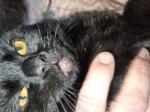Interesting Cat Fact Guide
This Interesting Cat Fact Guide came about as a result of my ongoing research. As I continue my constant search for more and more information on how to be a better cat lover, I have (surprisingly!) learned quite a bit.
My constant search for facts on cat behavior, feline health, statistics, cat care, cat food, and so on has taken me in many directions. Along the way, I have acquired many pieces of data that are either too fragmented to create an entire web page around, or don't fit in other categories. It has since turned into an entire cat facts section. Enjoy!
Table of Contents
Scientific Information About Cats
Cat Species Taxonomy Information
Cat Domestication
Cat Anatomy
Cat Hunting
Cat Litter Box
Cats and Plants
Cat Statistics
Cats and Humans
Scientific Information
- There are over 30 species of the mammal known as the cat - 37 to be exact, of which, the Domestic Cat, or House Cat, is one.
Species Taxonomy Information
- With respect to taxonomy, the domestic cat is classified as follows:
Genus: Felis
Species: catus - As are all 37 species of cat, it is a member of the Family Felidae, Order Carnivora.
- Full domestic cat taxonomy:
Kingdom: Animalia
Phylum: Chordata
Class: Mammalia
Order: Carnivora
Family: Felidae
Genus: Felis
Species: catus
Cat Domestication
- Cats are believed to have first been domesticated, by most accounts, somewhere between 4,000 and 5000 B.C., by the Egyptians.
Recent evidence, however, indicates that a close relationship with humans may date back much farther than that.
A grave found in Cyprus, estimated to be about 9,500 years old, shows that a cat was buried alongside a human, only inches away. - The Egyptian Mau, domesticated thousands of years ago,
is the only domestic cat breed recommended by the International Society for Endangered Cats (ISEC).
Cat Anatomy
- Cats use their tails not only to express emotion, but also to balance themselves.
- Cats can get sunburned (they also can get freckles). Light colored (especially white) cats are particularly susceptible to sunburn. Anywhere there is less hair to protect the animal, especially the tips of the ears, the nose, and the area just above the eyes, is at risk.
- Cat urine glows under a black light!
But so do many other body fluids from other animals, including human and dog urine. Don't be so quick to blame the cat! - The longest cat whisker on record as of February 15, 2004, measured 16.5 cm (6.5 in).
Ironically, the cat that it belongs to, a brown/black Maine Coon named Ellie, had no whiskers when her owners first adopted her from a shelter in 1997. She was only a few months old and very weak at the time. - It's interesting that the longest domestic cat is also a Maine Coon. Measuring 121.9 cm (48 in) from nose to tail, Leo weighs 15.8 kg (35 lb), and has paws so big they can fit into a size 2 child's shoe!
Update: Stewie, a 5 year old Maine Coon from Reno, Nevada took the title from Leo. Stewie, who owns Robin Hendrickson and Erik Brandsness, was measured on Aug. 28, 2010 at 48.5 inches. Unfortunately, Stewie passed away in 2013. See who the new record holder for longest cat is.
Hunting
- Cats stalk, hunt, and catch prey (or anything else, even each other, or you!) instinctively. But... associating hunting, killing, and food is a learned behavior. Young cats are typically taught to kill and eat their prey by their mothers.
The Cat Litter Box
- Some long haired cats prefer to eliminate on a smooth surface, such as the bottom of the litter box, rather than on the litter itself. Typically, they'll move all the litter to one side of the box to expose the bottom, and then cover things up when they are done. I've witnessed this in my own home.
- When outdoors, some cats will use a sandbox as a litter box. So be careful out there!
Cats and Plants
- Poinsettia is commonly thought to be a poisonous plant for cats. It is not, however, on the toxic plant list put out by the ASPCA. Note: I'm not saying that it is not poisonous to cats. As of the time of this writing, it is simply missing from the ASPCA's web based list of plants toxic to cats.
- Other names for the catnip herb:
catmint, catswort, field balm. - Catnip has been shown in studies to not only repel, but also kill termites!
- Nepetalactone is the name of the essential oil in catnip that gives it its aromatic odor. It's also the stuff that drives cats crazy!
- Catnip as a mosquito repellent? Researchers have determined that nepetalactone is 10 times more effective at repelling mosquitos than DEET - the chemical insect repellent. So, a new slogan may be... "nothing repels mosquitos better than catnip oil!"
Cat Statistics
- More than 30 percent of homes in the United States have cats.
- According to the Virginia Beach (VA, USA) SPCA, a study published in the New England Journal of Medicine showed that there is no correlation between cat ownership and toxoplasmosis infection.
- The primary means by which humans contract toxoplasmosis is NOT contact with cats or cat feces - it is by eating raw or undercooked meat.
This is exemplified by the extremely high rate of infection in France. Toxoplasmosis also may be contracted through contact with contaminated soil, although this is more likely in developing countries. - Guinness World Records no longer accepts entries for "heaviest cat." This, and other records have been eliminated due to ethical issues. It seems that people were feeding their animals unhealthy amounts of food in order to beat the record.
Cats and Humans
- Fear of cats (cat phobia) is known as ailurophobia (Greek - ailouros - cat). It is defined, by various sources, as:
an abnormal fear or aversion to cats
a fear of cats
a morbid fear of cats
Alternate names for fear of cats are aelurophobia, galeophobia, and gatophobia (Sp).



Comments: What do you think?
Have your say about what you just read. Leave me a comment in the box below.